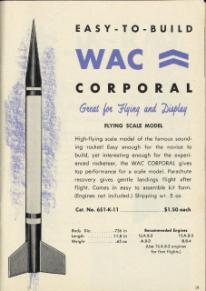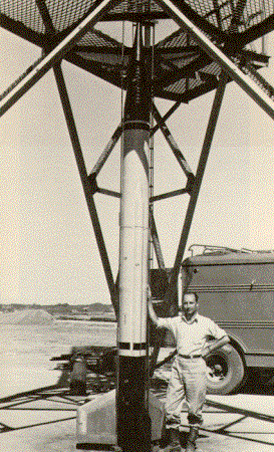 On September 11, 1966 I launched my first model rocket. It was the Estes starter kit - a scale WAC Corporal based on the BT-20 body tube. It flew on an Estes 1/2A.8-2 engine, and flew a second flight the same day on an A.8-3 before being retired from flight duty.
On September 11, 1966 I launched my first model rocket. It was the Estes starter kit - a scale WAC Corporal based on the BT-20 body tube. It flew on an Estes 1/2A.8-2 engine, and flew a second flight the same day on an A.8-3 before being retired from flight duty.
When considering a suitable Level 3 project, the WAC was a natural sentimental choice, and since the original WAC still survives in my collection, re-flying it as a payload in the Level 3 bird was suggested. In considering the scale for the project, I was influenced by my son who is particularly fond of the visual impact made by very large scale HPR projects. After some discussion we settled on a large "low and slow" design as close as possible to a full scale reproduction of the original.
The project is designed around the PML 11.4" diameter airframe and will stand about 16 feet high. The design incorporates a 98 mm motor mount, for the single-motor certification flight.Ê Also included will be three auxiliary 54 mm motor mounts for cluster/airstart flights later, or possibly also for stage coupling to a scale Tiny Tim booster if such a project is undertaken at a later date.
For economic reasons, the plan calls for the certification flight to be carried out using a Hypertek M hybrid motor. Because of the comparatively modest thrust level of the hybrid motor, an important design constraint on the project will be to keep the weight as low as possible, so as to avoid takeoff speeds that are too low. As outlined in this proposal, the weight will be managed where possible with the use of lightweight construction materials and techniques.. The target weight for the rocket without motor is 1050 oz. (65 pounds), which yields an acceptable liftoff velocity off the rail of approximately 60 feet per second.
 The WAC Corporal, America's first sounding rocket, started life in WWII, when reports of the German missile programs reached the California Institute of Technology. Caltech's GALCIT (Guggenheim Aeronautical Laboratory at the California Institute of Technology), precursor to the present-day JPL, proposed a U.S. program of missile development, and the Army Ordnance department agreed to fund this project, called ORDCIT. By late 1944, it was clear from progress in the Private and Corporal missile programs that ORDCIT was well situated to build a sounding rocket. Frank Malina, ORDCIT's director [shown in picture], and other Caltech workers had originally entered the missile business with a sounding rocket in mind, so the sounding rocket justified as a developmental version of the (much larger) Corporal missile, was proposed to the Army. The Army approved of this "little sister" to the Corporal, and funded the WAC Corporal (WAC either stood for Women's Army Corps, reflecting the little sister metaphor, or Without Attitude Control, reflecting the simplicity of the rocket).
The WAC Corporal, America's first sounding rocket, started life in WWII, when reports of the German missile programs reached the California Institute of Technology. Caltech's GALCIT (Guggenheim Aeronautical Laboratory at the California Institute of Technology), precursor to the present-day JPL, proposed a U.S. program of missile development, and the Army Ordnance department agreed to fund this project, called ORDCIT. By late 1944, it was clear from progress in the Private and Corporal missile programs that ORDCIT was well situated to build a sounding rocket. Frank Malina, ORDCIT's director [shown in picture], and other Caltech workers had originally entered the missile business with a sounding rocket in mind, so the sounding rocket justified as a developmental version of the (much larger) Corporal missile, was proposed to the Army. The Army approved of this "little sister" to the Corporal, and funded the WAC Corporal (WAC either stood for Women's Army Corps, reflecting the little sister metaphor, or Without Attitude Control, reflecting the simplicity of the rocket).
The WAC was 24 feet long, with the sustainer (excluding the Tiny Tim booster) measuring 16 feet. .
Wac Corporal rockets were launched from a launch tower similar to those used for tests conducted by Dr. Robert Goddard. Test launches of the Wac Corporal were conducted at the White Sands Proving Ground in New Mexico, although tests of the rocket did not occur there until September, 1945 after World War II had ended.
The WAC flew in various configurations and paint schemes during the program. The version modeled in this project is Round 5, which has been historically well documented and sports a distinctive yellow and black paint scheme, different and more eye-catching than the often modeled black and white version. Round 5 was the first fully fueled WAC flight, and was launched successfully on Oct. 11, 1945 to an altitude of 43.5 miles (70 km).

On September 11, 1966 I launched my first model rocket. It was the Estes starter kit - a scale WAC Corporal based on the BT-20 body tube. It flew on an Estes 1/2A.8-2 engine, and flew a second flight the same day on an A.8-3 before being retired from flight duty.
The WAC Corporal, America's first sounding rocket, started life in WWII, when reports of the German missile programs reached the California Institute of Technology. Caltech's GALCIT (Guggenheim Aeronautical Laboratory at the California Institute of Technology), precursor to the present-day JPL, proposed a U.S. program of missile development, and the Army Ordnance department agreed to fund this project, called ORDCIT. By late 1944, it was clear from progress in the Private and Corporal missile programs that ORDCIT was well situated to build a sounding rocket. Frank Malina, ORDCIT's director [shown in picture], and other Caltech workers had originally entered the missile business with a sounding rocket in mind, so the sounding rocket justified as a developmental version of the (much larger) Corporal missile, was proposed to the Army. The Army approved of this "little sister" to the Corporal, and funded the WAC Corporal (WAC either stood for Women's Army Corps, reflecting the little sister metaphor, or Without Attitude Control, reflecting the simplicity of the rocket).
